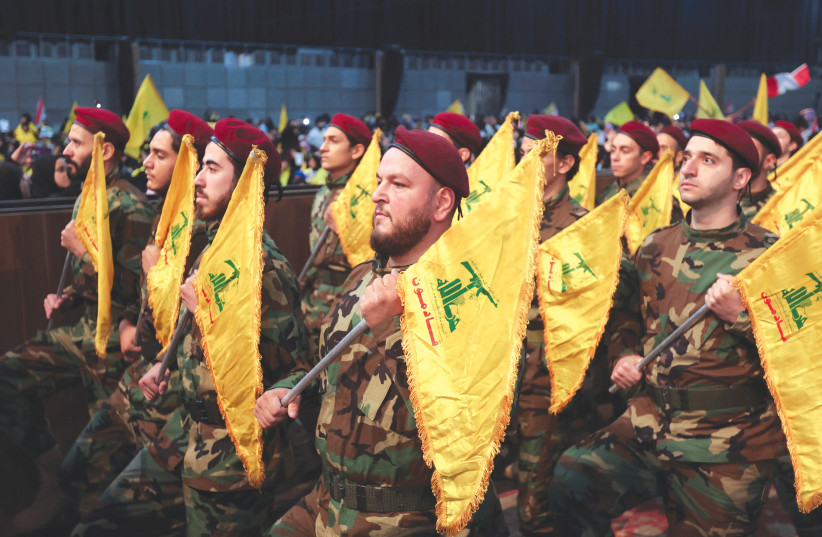How can the IDF most effectively target Hezbollah in Lebanon?
In the last nine months, the IDF’s bank of targets in the campaign against Hezbollah has mainly included military infrastructure within a range of tens of kilometers from the Israeli border, and in exceptional cases, also within a range of 100 kilometers.
The targets included, among others, observation posts, outposts, camps, launch sites, command and control centers, weapons manufacturing sites, UAV launch runways, surface-to-air missile batteries, launch vehicles, launch pits, and combat complexes that supported the Radwan force‘s (Hezbollah’s elite force against the Israeli home front) attack plan.
In addition, the IDF has killed over 350 operatives, including senior commanders in Hezbollah’s military wing and more than 150 terrorists from other organizations in Lebanon such as Islamic Jihad, Hamas, Amal, and Al-Jama’a Al-Islamiyya.
A scenario of total war against Hezbollah would require the IDF to expand the list of targets to cover all of Lebanon, with an emphasis on two focal points: Beirut and the Bekaa Valley. In 2006, debates were revealed between the political and security leadership on whether it was appropriate to destroy the civilian infrastructure of the state of Lebanon or to focus on the state of Hezbollah.
As mentioned, over the past 15 years, the Shiite organization, with Iranian assistance, has made efforts to differentiate itself from the state of Lebanon in areas such as education, medicine, infrastructure such as energy, water, finance, and more. Even at the Al-Hariri Airport in Beirut, Hezbollah created its own terminal through which it could smuggle weapon systems, ammunition, components, and raw materials for manufacturing weapons without exposure to Lebanese officials or foreign entities.

According to Tal Be’eri, head of research at the Alma Research Institute, which monitors Hezbollah, it would be a mistake to attack the infrastructure of Lebanon, supported by the US, France, and Germany, as this could potentially damage the international legitimacy of actions against the Shiite organization.
“The IDF’s bank of targets should focus solely on Hezbollah. If there’s a warehouse containing weapons and ammunition at the airport in Beirut, it’s clear that it should be targeted. However, it’s not correct to target civilian infrastructure. If there’s a Hezbollah military station? It should be attacked, but not Lebanese state stations in Zahle, Tripoli, and Beirut. Attacking Lebanon’s infrastructure doesn’t really bother Hezbollah. If there are weapons adjacent to those infrastructures, that’s a different story.”
Hezbollah’s infrastructure
Hezbollah has a network of gas stations, fuel reservoirs, and independent solar infrastructure, which includes financial infrastructure like exchange offices and a banking network.
Hezbollah’s communication system includes antennas, transmitters, telephone exchanges, television channels, radio stations, newspapers, websites, and a psychological warfare and spokesperson system.
Hezbollah has its own electricity system and water plants that serve the organization’s operatives, including the military wing. In certain locations, Hezbollah operates an independent solar system throughout Lebanon to avoid reliance on Lebanese state systems.
There are also civil infrastructure companies that are associated with Hezbollah and are involved in the construction of Hezbollah’s military infrastructure (outposts, camps, underground systems, bridges, etc.).
Finally, all civilian infrastructure is under the supervision of Jihad al-Bina – Hezbollah’s Construction Ministry, which operates under the organization’s executing council. It manages all institutions of the state of the terror organization, responsible for rebuilding their infrastructure after wars, and operates under the Iranian-backed Jihad al-Bina organization.
IDF must focus on the following targets
Firstly, above all, the IDF will need to target the strategic assets of the organization: Ballistic missiles, precision-guided missiles, ground-to-air missile systems, underground bunkers, launch sites, and maritime infrastructures to prevent raids and attacks.
Secondly, the IDF will need to target launch sites, rocket stockpiles for medium and long-range rockets, ammunition depots, command centers, and control facilities in the Dahiya quarter, the Bekaa Valley, and in other areas.
Thirdly, in southern Lebanon, the IDF must target short-range rockets, long-range anti-tank missiles, positions and command centers, movement axes, and covert sites of the Radwan force to neutralize its capability to threaten the Israeli border.
Top-tier capabilities
In the past decade, the Israeli air force has demonstrated top-tier capabilities in high-precision and rapid airstrikes. Yet, several questions remain: Will the IDF surprise or be surprised in a potential Third Lebanon War? Will it initiate decisive actions like targeted assassinations? And will it employ its full spectrum of capabilities in air, land, and sea?
Such capabilities require meticulous and precise preparations that involve high-level coordination and deception. The question is whether the Israeli government will opt for a diplomatic arrangement, a limited operation with ground incursions to create a security buffer zone, or a full-scale war against Hezbollah.
Hinting at the IDF’s capabilities last month, IDF Chief of Staff Lieutenant General Aviv Kochavi, following Hezbollah’s missile and rocket attacks near the northern border, stated, “We are preparing and building solutions to deal with such capabilities and others that, when the time comes, will also see their implementation as needed. We certainly hold unparalleled capabilities, which I think the enemy only partly knows about, and they will encounter them when necessary at the right time.”





Comments are closed.